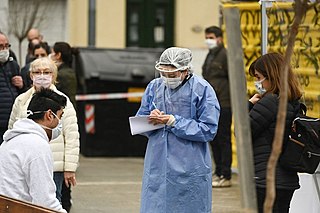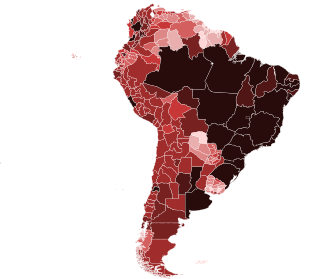Contents
| |||||
| Decades: | |||||
|---|---|---|---|---|---|
| See also: | |||||
| |||||
| Decades: | |||||
|---|---|---|---|---|---|
| See also: | |||||
| | This section needs expansion. You can help by adding to it. (January 2020) |
| | This section needs expansion. You can help by adding to it. (January 2020) |

Tear gas, also known as a lachrymatory agent or lachrymator, sometimes colloquially known as "mace" after the early commercial self-defense spray, is a chemical weapon that stimulates the nerves of the lacrimal gland in the eye to produce tears. In addition, it can cause severe eye and respiratory pain, skin irritation, bleeding, and blindness. Common lachrymators both currently and formerly used as tear gas include pepper spray, PAVA spray (nonivamide), CS gas, CR gas, CN gas, bromoacetone, xylyl bromide and Mace.
Indigenous peoples in Chile or Native Chileans form about 13% of the total population of Chile. According to the 2017 census, almost 2,200,000 people declare having indigenous origins. Most Chileans are of partially indigenous descent; however, indigenous identification and its legal ramifications are typically reserved to those who self-identify with and are accepted within one or more indigenous groups.

A series of massive demonstrations and severe riots, known in Chile as the Estallido Social, originated in Santiago and took place in all regions of Chile, with a greater impact in the regional capitals. The protests mainly occurred between October 2019 and March 2020, in response to a raise in the Santiago Metro's subway fare, a probity crisis, cost of living, university graduate unemployment, privatisation, and inequality prevalent in the country.
The COVID-19 pandemic in Spain has resulted in 13,980,340 confirmed cases of COVID-19 and 121,852 deaths.
The COVID-19 pandemic in Ecuador was a part of the worldwide pandemic of coronavirus disease 2019 caused by severe acute respiratory syndrome coronavirus 2. The virus was reported to have spread to Ecuador on 29 February 2020, when a woman in her 70s tested positive for the virus. Ecuador was described in April as emerging as a possible "epicentre" of the pandemic in Latin America, with the city of Guayaquil overwhelmed to the point where bodies were being left in the street.

The COVID-19 pandemic in Argentina is part of the worldwide pandemic of coronavirus disease 2019 caused by severe acute respiratory syndrome coronavirus 2. As of 17 August 2024, a total of 10,101,218 people were confirmed to have been infected, and 130,663 people were known to have died because of the virus.

The worldwide pandemic of coronavirus disease 2019 caused by severe acute respiratory syndrome coronavirus 2 severely affected Chile. The virus was confirmed to have reached Chile on 3 March 2020. Initial cases had been imported from Southeast Asia and Europe, and expanded into a large number of untraceable infections, placing the country within phase 4 of the pandemic as defined by the World Health Organization, with over 1,000 confirmed cases by 25 March 2020.

The COVID-19 pandemic in Paraguay was a part of the ongoing worldwide pandemic of coronavirus disease 2019 caused by severe acute respiratory syndrome coronavirus 2. The virus was confirmed to have reached Paraguay on March 7, 2020, in a 32-year-old man from Guayaquil, Ecuador, living in San Lorenzo, Central Department. Three days later, on March 10, 2020, a second case was confirmed in a 61-year-old man who traveled from Argentina; the same day three more cases were confirmed. Due to this spike, the government began imposing the first measures to stop the disease from spreading.

The COVID-19 pandemic was confirmed to have reached South America on 26 February 2020 when Brazil confirmed a case in São Paulo. By 3 April, all countries and territories in South America had recorded at least one case.

The COVID-19 pandemic in Venezuela was a part of the worldwide pandemic of coronavirus disease 2019 caused by severe acute respiratory syndrome coronavirus 2. The first two cases in Venezuela were confirmed on 13 March 2020; the first death was reported on 26 March. However, the first record of a patient claiming to have symptoms of coronavirus disease dates back to 29 February 2020, with government officials suspecting that the first person carrying the virus could have entered the country as early as 25 February.

The COVID-19 pandemic was confirmed to have reached the Chilean island and special territory of Easter Island in March 2020.

Protests, demonstrations and strikes occurred around the world against national responses to the COVID-19 pandemic by governmental bodies. Some were driven by the financial hardship resulting from government measures to contain the virus, including restrictions on travel and entertainment, hitting related industries and workers hard. Protests also occurred in opposition to restrictions on people's movements, compulsory wearing of face masks, lockdowns, vaccinations and other measures. Some protests were driven by COVID-19 misinformation, conspiracy theories, far-right and other extremist groups and individuals.

Indian migrant workers during the COVID-19 pandemic have faced multiple hardships. With factories and workplaces shut down due to the lockdown imposed in the country, millions of migrant workers had to deal with the loss of income, food shortages and uncertainty about their future. Following this, many of them and their families went hungry. Thousands of them then began walking back home, with no means of transport due to the lockdown. A study found that 43.3 million interstate migrants returned to their home during the first wave of Covid-19 led lockdowns and out of 43.3 million around 35 million walked home or used unusual means of transportation. In response, the Central and State Governments took various measures to help them, and later arranged transport for them. 198 migrant workers died due to the lockdown, with reasons of road accidents.

The 2019–2020 Chilean protests are characterised by widespread eye injuries, including many globe ruptures, among protesters as result of Chilean riot police's use of rubber bullets and tear gas grenades. Data from the National Institute of Human Rights (INDH) shows that the use of rubber bullets and pellets by security forces has left at least 1,863 injured, including 268 with eye problems. According to the Chilean Ophthalmology Society, this is the highest number of injuries of this type registered during protests or in conflict zones in the world. In late November, security forces announced the suspension of the use of rubber pellets as a crowd control method in the protests. The INDH updated figures at the end of January 2020 reporting that 427 persons had received eye injuries at the hands of the police. Almost 90% of the injured are men. As of early January 2020 the age of injured goes from 14 to 59 years, and averages 28 years.
María Soledad Cisternas Reyes is a Chilean lawyer and disability rights activist. Cisternas, who became blind while she was in college has worked to increase access for people with disabilities in Chile and at the United Nations (UN). She was on the committee that drafted the Convention on the Rights of Persons with Disabilities and served as the chairperson on the Committee on the Rights of Persons with Disabilities. In 2017, Cisternas was appointed the Special Envoy on Disability and Accessibility for the UN.
The 2020 COVID-19 pandemic in Argentina affected the human rights situation in the country.
Events from 2020 in Easter Island.

Squatting in Chile is the occupation of unused land or derelict buildings without the permission of the owner. From the 1960s onwards, informal settlements known as callampas were permitted although there were also evictions such as the massacre of Puerto Montt in 1969. In the 1970s, the government of Salvador Allende encouraged occupations, then following the coup d'état, the military junta repressed squatting. Callampas then became known as campamentos.

Fabiola Andrea Campillai Rojas is a Chilean Senator known for losing her sight in a case of police brutality in the 2019 Chilean protests.